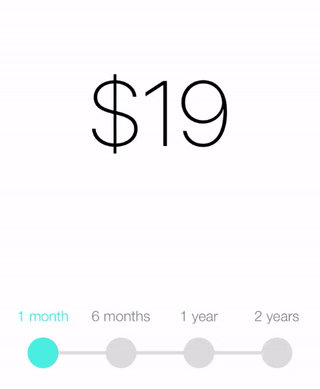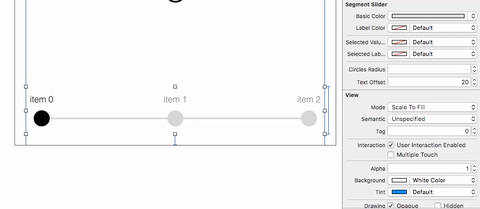MMSegmentSlider is an easy-to-use IBDesignable animated slider for iOS 7+ written in Objective-C.
CocoaPods is a dependency manager for Objective-C, which automates and simplifies the process of using 3rd-party libraries like MMSegmentSlider in your projects. First, add the following line to your Podfile:
pod 'MMSegmentSlider'If you want to use the latest features of MMSegmentSlider use normal external source dependencies.
pod 'MMSegmentSlider', :git => 'https://github.com/MedvedevMax/MMSegmentSlider'This pulls from the master branch directly.
Second, install MMSegmentSlider into your project:
pod installCarthage is a decentralized dependency manager that builds your dependencies and provides you with binary frameworks.
You can install Carthage with Homebrew using the following command:
$ brew update
$ brew install carthageTo integrate MMSegmentSlider into your Xcode project using Carthage, specify it in your Cartfile:
github "MedvedevMax/MMSegmentSlider"
Run carthage update to build the framework and drag the built MMSegmentSlider.framework (in Carthage/Build/iOS folder) into your Xcode project (Linked Frameworks and Libraries in Targets).
- Drag the
MMSegmentSliderfolder into your project. - Enjoy it
(see sample Xcode project in /demo)
MMSegmentSlider is completely IBDesignable and IBInspectable. This means you can customise it right in the Interface Builder and see the changes immediately.
The simplest way to use MMSegmentSlider is to add an empty view and set the class to MMSegmentSlider. Then you can customise its appearance right in the Attribute Inspector. Though you should note that the font for labels can only be customised from the code:
segmentSlider.labelsFont = [UIFont fontWithName:@"HelveticaNeue-Light" size:14.0f];You can also instantiate MMSegmentSlider like any other UIControl right from the code and use the following properties to change the look of the slider:
@property (nonatomic, strong) UIColor *basicColor;
@property (nonatomic, strong) UIColor *labelColor;
@property (nonatomic, strong) UIColor *selectedValueColor;
@property (nonatomic, strong) UIColor *selectedLabelColor;
@property (nonatomic) NSInteger circlesRadius;
@property (nonatomic) NSInteger textOffset;
@property (nonatomic, strong) UIFont *labelsFont;To set values for items use:
segmentSlider.values = @[@"$19", @"$99", @"$199", @"$299"];This values are not visible and will only be returned when you retrieve the selected value:
priceLabel.text = (NSString *)segmentSlider.currentValue;To set labels for these values use:
segmentSlider.labels = @[@"1 month", @"6 months", @"1 year", @"2 years"];You can also get the index of the selected item using the following property:
@property (nonatomic) NSInteger selectedItemIndex;Note that it's not readonly, so you can change current value using it. If you want to animate changing use this method instead:
- (void)setSelectedItemIndex:(NSInteger)selectedItemIndex animated:(BOOL)animated;MMSegmentSlider is distributed under the terms and conditions of the MIT license.
MMSegmentSlider is brought to you by Max Medvedev. If you're using MMSegmentSlider in your project, attribution would be very appreciated.





